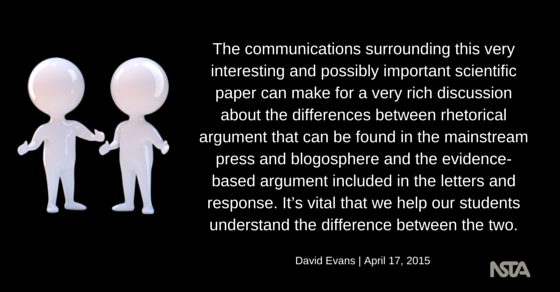Science and the Media
By David Evans, NSTA Executive Director
Posted on 2015-04-17
Scientists Christian Tomasetti and Bert Vogelstein published an article in the journal Science, “Variation in cancer risk among tissues can be explained by the number of stem cell divisions” (Science, January 2, 2015, p 78). The discussion this article engendered provides an excellent teaching tool for teachers to showcase how scientific debate takes place among members of the scientific community with the goal to elevate the quality of a body of knowledge and how it is different from the way the popular press reports on and communicates this work.
The amount and range of news coverage this research article received was remarkable. Most of the popular press, unfortunately, reported a simplified version of the story citing the statement that two-thirds of cancers are caused by chance and not by genetic or environmental factors without noting that that the authors explicitly stated that a number of the most commonly occurring cancers were not included in their study. Few of the news accounts reported that the original article addressed variation in cancer risk but not absolute cancer risk, therefore misleading readers that most cancers are due to ‘bad luck.’ The Guardian ran a story, “Bad luck, bad journalism and cancer rates,” that tried to clarify the science for the popular media and provided a simple account of the actual work while chastising colleagues in the news business.
In contrast to often poorly reasoned discussion in the popular press, members of the science community weighed in with criticism as well. Authors of six letters in the journal Science raised a number of mathematical and procedural questions about the work. Many of them were also as concerned with how people would interpret the results as they were with identifying errors. For example, the letter by Ashford, et al., begins “The report […] is dangerously misleading….” And in a subsequent blog post, one of the authors writes, “Our letter to the editor of Science not only challenges the misstatements of the reports that most cancers are due to ‘bad luck’, but points out that such misstatements dangerously undermine successful efforts to prevent cancers.”
In their response to the letters, Tomasetti and Vogelstein address each of the technical points either directly or by referring to the Supplementary Materials published online by Science. They also offer their views on the non-scientific aspects of the criticism. I encourage you to read the letters as well as the response.
The communications surrounding this very interesting and possibly important scientific paper can make for a very rich discussion about the differences between rhetorical argument that can be found in the mainstream press and blogosphere and the evidence-based argument included in the letters and response. It’s vital that we help our students understand the difference between the two.
 Dr. David L. Evans is the Executive Director of the National Science Teachers Association. Reach him at devans@nsta.org or via Twitter @devans_NSTA.
Dr. David L. Evans is the Executive Director of the National Science Teachers Association. Reach him at devans@nsta.org or via Twitter @devans_NSTA.
The mission of NSTA is to promote excellence and innovation in science teaching and learning for all.
Follow NSTA
Disclaimer: The views expressed in this blog post are those of the author(s) and do not necessarily reflect the official position of the National Science Teaching Association (NSTA).



